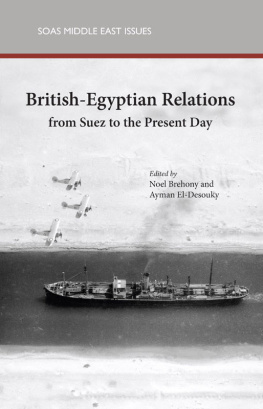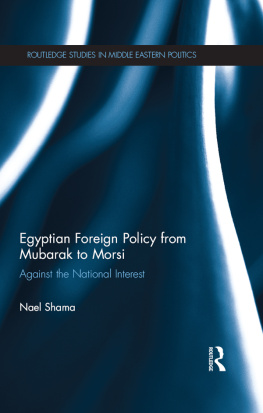Egypt and the Sudan
By the same author
The Sudan under Wingate
Islam, Nationalism and Communism in a Traditional Society: The Case of Sudan
(co-editor with Uri M. Kupferschmidt)
Islam Nationalism and Radicalism in Egypt and Sudan in the 20th Century
First published 1985 by Frank Cass and Co, Ltd
This edition published 2013 by Routledge
2 Park Square, Milton Park, Abingdon, Oxon OX14 4RN
711 Third Avenue, New York, NY 10017
Routledge is an imprint of the Taylor & Francis Group, an informa business
Copyright 1985 Gabriel R. Warburg
British Library Cataloguing in Publication Data
Warburg, Gabriel R.
Egypt and the Sudan.
1. EgyptHistory1798 2. SudanHistory
I. Title
962. 04 DT100
ISBN 0-7146-3247-3
All rights reserved. No part of this publication may be reproduced in any form or by any means, electronic, mechanical, photocopying, recording, or otherwise, without the prior written permission of the publisher.
To my mother Ilse, and to Rachel with love
Contents
PART ONE
BRITAINS MOMENT IN THE NILE VALLEY
PART TWO
REGIONAL AND POLITICAL CONSIDERATIONS
Most of the studies which make up this book were originally published in the following journals or collections: Asian and African Studies, Journal of Contemporary History, Middle Eastern Studies, The Jerusalem Quarterly; The Contemporary Mediterranean World , eds. C.F. Pinkele and A. Pollis, New York, Praeger 1983; The Great Powers in the Middle East 19191939 , ed. U. Dann, New York & London, Holmes & Meier (forthcoming). I am grateful to the editors and publishers of the above for kindly enabling me to use these studies for republication. I would also like to thank the staff of the Public Record Office, London, for their kind help. Crown Copyright records appear by permission of the Controller, Her Majestys Stationery Office.
All the studies in this volume have been rewritten and in some cases considerably enlarged, to take account of new material which has become available since they were first published.
Gabriel R. Warburg
Haifa
| AAS | Asian and African Studies , The Israel Oriental Society, The Institute of Middle Eastern Studies, Haifa University |
| F.I.B.S.-M.E.A. | Foreign Broadcasting Information Service - Middle Eastern Affairs |
| FO | Foreign Office Archive, Public Record Office London |
| IJMES | International Journal of Middle East Studies , The Middle East Studies Association of North America, Cambridge University Press |
| M.E.C.S. | Middle East Contemporary Survey , (eds.) Colin Legum and Haim Shaked, New York & London, Holmes & Meier Publishers Inc. |
| MEJ | Middle East Journal , Washington D.C., The Middle East Institute |
| MES | Middle Eastern Studies , London, Frank Cass & Co. |
| SAD | Sudan Archive Durham, the Wingate Papers and other private archives relating to the Sudan; deposited at the School of Oriental Studies, Durham University |
| SIR | Sudan Intelligence Report |
| SSIR | Secret Sudan Intelligence Report |
Note on Transliteration
Due to technical reasons no diacritical marks have been used in Arabic terms or names, except for the ayn () and the hamza ().
The studies included in this volume attempt to examine certain aspects of the history of Egypt and the Sudan in the nineteenth and twentieth centuries. Most of these studies are concerned with the triangular relationship between England, Egypt and the Sudan which evolved during the period of Britains rule in the Nile Valley between 1882 and 1956.
The Nile is indeed of central importance in the study of Egypt and the Sudan and justifies a comparative study of these two separate political entities. The search for the sources of the Nile in the second half of the nineteenth century brought the Egyptians to the Equatorial regions of the Sudan and ultimately led to their conquest and incorporation into the Turco-Egyptian Sudan. Thus, even in a study limited to the political rather than the economic aspects of the Nile Valley, the Nile predominates as the single most important factor in the relations between these two regions. The fear of a hostile regime in Khartoum became a crucial consideration for whoever ruled in Cairo. For the free use of Nile waters for irrigation in the Sudan, or, even worse, their diversion to some hitherto uncultivated lands, became a constant threat to Egypts very existence. Egypts rulers were therefore opposed to their forced evacuation from the Sudan in 18831885 and regarded the Mahdist state, throughout its existence, as a possible threat to Egypt. This threat became even more acute when Britain ruled the Sudan under the guise of the Anglo-Egyptian Condominium. The Unity of the Nile Valley, which had been propagated by the Egyptian Nationalist party under Mustafa Kamil since the 1890s, remained the cornerstone of Egyptian nationalism throughout the period of British occupation.
In a study comparing British rule in Egypt to its rule in the Sudan an attempt is made to determine if, and to what extent, British ability to dominate these regions was influenced by the availability and exploitation of indigenous collaborating elites. Furthermore, while it is recognised that various Eurocentric components determined imperial expansion, the conquest of Egypt and the Sudan and their eventual emergence as independent nation-states are also examined against the background of the breakdown of collaboration between rulers and ruled. This study, which embraces the whole period of British rule in the Nile Valley, is an attempt to examine if and to what extent the workings of British imperialism were determined by indigenous collaborative systems connecting its European and African components.
Several findings emerge. First, it is quite clear that an examination such as this enables us to understand better the various methods by which imperial powers ruled the vast areas of their colonies with negligible use of military power. Second, the fact that there were two imperial powers, England and Egypt, simultaneously seeking to control the Sudan meant that the local elites tended to split into anti-Egyptian and anti-British factions, thereby facilitating each powers quest for collaborators. In Egypt the situation was more complex since all the components of the indigenous elite sought an early end to British occupation and the reunification of Egypt and the Sudan. Nonetheless, the internal power struggle between the King and his allies, on the one hand, and the Wafd on the other, enabled Britain to retain its paramountcy through collaboration with one or the other of the two power blocs. A third finding which emerges is that collaboration was not a one-sided affair - the indigenous elites had their own reasons for collaborating with the imperial power. Thus the Wafd in Egypt and the Ansar in the Sudan sought to exploit their alliance with Britain in order to further their own political and economic ambitions. This of course proved to be a two-edged sword, for while they benefited from British support in the short run, they found themselves at least partly discredited later on. Finally, while taking into account the complex reasons for Britains departure from Egypt and the Sudan in 19551956, the fact that she had run out of effective collaborators in both these territories should be borne in mind.












